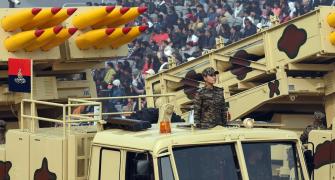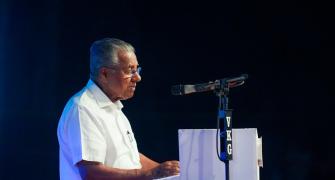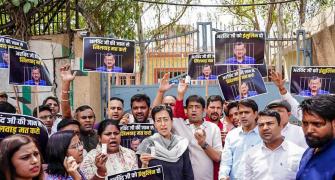At stake were not only the lives of the astronauts, but also America's pride in its technological prowess, the fate of the US space program and the future of space exploration itself.
"Our long wait may be over. So on behalf of the many millions of people who believe so deeply in what we do, good luck, Godspeed -- and have a little fun up there," launch director Mike Leinbach told the astronauts just before liftoff.
Space program employees and relatives of both the Discovery and Columbia crews watched nervously as the shuttle rose from its pad at 10:39 a.m., climbed into a hazy midsummer sky, skirted two decks of clouds and headed out over the ocean in the most scrutinized launch in NASA history.
Two chase planes and more than 100 cameras documented the ascent from every possible angle to capture any sign of flying debris of the sort that doomed the last flight.
Video showed what might have been at least two light-colored objects flying off Discovery as the shuttle cleared the launch pad, and what appeared to be a large piece of debris coming off the external fuel tank two minutes into the flight.
NASA's next flight to have rescue shuttle
Deputy shuttle program manager Wayne Hale raised the possibility that the light-colored objects were harmless pieces of paper that protect Discovery's thrusters before launch. But he insisted it was too soon to say what the cameras may have picked up, and he gave assurances the multitude of images will be examined frame by frame in the coming hours and days.
"No telling what might be there or what's not there -- we hope nothing," he said.
The fuel gauge that thwarted a launch attempt two weeks ago worked properly before and during the liftoff, to NASA's relief, and the countdown was remarkably smooth. If the sensors had acted up before liftoff, the space agency had been prepared to bend its safety rules to get the shuttle flying.
A TV camera mounted on Discovery's giant orange external fuel tank provided an unprecedented view of the shuttle's entire climb to orbit in spectacular orange and blue, and showed the shuttle banking away and the empty tank being jettisoned back toward Earth to burn up in the atmosphere.
"I ask you all to take note of what you saw here today: the power and the majesty of launch, of course, but also the confidence and the professionalism, the sheer gall, the pluckiness, the grittiness of this team that pulled this program out of the depths of despair 2 1/2 years ago and made it fly," NASA Administrator Michael Griffin said shortly after the launch.
Across the country, Americans watched the liftoff, cheering and applauding as it roared into a brilliant blue sky. "I am very proud," said Airman First Class Daniel Tureac of Brooklyn, who watched the launch on a giant screen at Times Square.
"I am part of the Air Force and this is the highest up you can go, being on a shuttle crew. This is very exciting."
In the hometown of Japanese astronaut Soichi Noguchi, firecrackers were popped and congratulatory cheers of "Banzai!" rang out.
During the 12-day mission, commander Eileen Collins and her crew will deliver supplies to the international space station and test new techniques for inspecting and patching the shuttle in orbit.
The 114th shuttle liftoff came after a humbling self-examination on NASA's part, extensive safety modifications to the spacecraft and many months of hurdles and setbacks.
A launch attempt July 13 was scrubbed after one of four critical hydrogen-fuel gauges in the external tank failed just two hours before liftoff.
Hundreds of engineers chased the problem, which had cropped up three months earlier in a fueling test. In the end, they could not fully explain the trouble but fixed some bad electrical grounding inside the shuttle in hopes that might solve it.
Griffin said the shuttle was as safe as NASA could make it, but was still a risky venture.
"Some things simply are inherent to the design of the bird and cannot be made better without going and getting a new generation of spacecraft. That's as true for the space shuttle as it is for your toaster oven," he told The Associated Press on the eve of launch.
Columbia was brought down by a suitcase-size piece of foam insulation that broke off the big external fuel tank during liftoff and caused a gash that allowed hot gases into the wing during the return to Earth 16 days later on Feb. 1, 2003.
Discovery to carry Kalpana's picture
But NASA could barely make out the blow in the photographs of the launch because the few available images were poor.
The space agency added more and better surveillance cameras for Discovery's launch and sent up a pair of camera-equipped planes to chase the flight. As soon as the shuttle reached orbit, the astronauts took digital pictures of the tank falling away.
Spy satellites will also photograph the shuttle in coming days, and once Discovery arrives at the space station on Thursday, the two residents will take pictures of the spacecraft as it executes a slow flip.
NASA's chief acknowledged a lot is riding on the flight: the shuttle program, the space station program, President Bush's plan to send astronauts back to the moon and on to Mars -- and seven lives.
"It's about hope, it's about imagination, it's about the future, and when you take away a great space program, you take away a lot of people's future," Griffin told the AP. "What's riding on this flight is people's hope for the future."
Almost 2,500 guests of NASA, including first lady Laura Bush and brother-in-law Gov. Jeb Bush, cheered, whistled and clapped as the shuttle lifted off, watching through sunglasses as it climbed. The spectators also included members of Congress, as well as relatives of the 14 fallen Columbia and Challenger astronauts. They sang the national anthem just minutes before liftoff.
The first lady said it is "pretty terrific" that the mission commander is a woman. "You're inspiring everybody," she later told launch controllers, following liftoff.
"We're really happy to see that there's been a safe launch," said astronaut David Wolf, who watched from the ground. But he added: "We still have the orbital phase and re-entry, of course. Really the mission has just begun _ let's not forget that."
In addition to Collins and Noguchi, the crew members are pilot James Kelly; Stephen Robinson; Andrew Thomas; Wendy Lawrence; and Charles Camarda.
In all, nearly 50 safety improvements were made to the shuttle in the wake of Columbia tragedy. The fuel tank was extensively redesigned, with less foam insulation than before but extra heaters to prevent a dangerous buildup of ice once it is filled with super-cold liquid propellant. NASA feared falling ice could be as lethal as chunks of foam.
Also, dozens of motion and temperature sensors were embedded in the wings to detect any blows from debris.
In addition, the space agency revamped the way it makes decisions and listens to dissenting views, especially from lower-level employees. Columbia accident investigators blamed the catastrophe in part on a broken safety culture, or a tendency to downplay risks and discourage engineers from speaking up.
Unlike the Columbia astronauts, who had no knowledge of the gaping hole in their spacecraft's wing and no realistic way of plugging it, the Discovery crew has a variety of inspection and repair techniques on board.
But they are all untested. And even the best of the bunch could not fix a hole the size of the one that destroyed Columbia.
The astronauts will try out the repair kits on deliberately broken samples of thermal tiles and panels. They will practice working with goo and other patching materials and different types of brushes, putty knives and a caulking gun.
They also will spend their first full day in space using a remote-control, 50-foot boom to inspect the shuttle's most vulnerable areas _ the wings and nose cap _ for any cracks and holes.
If any serious damage is found, NASA will have to choose between attempting repairs or, more likely, moving the shuttle crew into the space station for at least a month to await rescue by space shuttle Atlantis, which is already being readied for liftoff.
Both scenarios are extremely risky. Faced with so many uncertainties, the liftoff was a relatively solemn affair. NASA did not plan to hold the usual post-launch party, but the launch control team ate cornbread and beans in a post-liftoff tradition not enjoyed in 2 1/2 years.
"The mood was just giddy. People were just slapping each other on the back," Leinbach said. "And there will be only one thing better than today's launch, and that will be the landing in 12 days."
On the Net: NASA:







